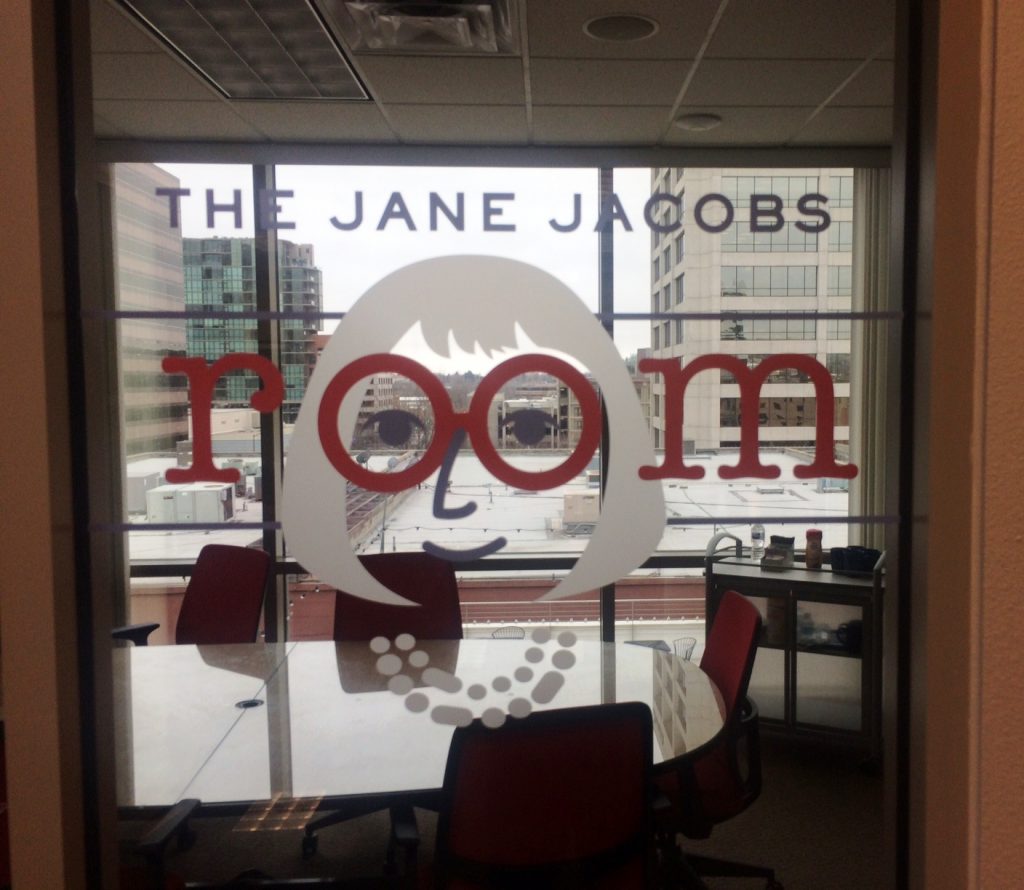“The Jane Jacobs Room” Honors Citizen Activist
CCDC’s Jane Jacobs Room honors an urbanist and activist who offered a new vision for diverse and vibrant redevelopment that prioritized people over automobiles. CCDC’s relentless pursuit of building a bodacious Boise is guided by her practical ideas and willingness to disrupt conventional city planning paradigms.
 So who was Jane Jacobs (1916-2006)? Best known for her writings about cities, her first book, The Death and Life of Great American Cities (1961), upended the ideas of modernist, auto-centric, city planning, and building. She offered a new vision, one of diverse, fine-grained cities made for and by ordinary people. After moving from New York City to Toronto in 1968, she published six more major books about cities, economics, ethics, governance and culture, two of them Canadian bestsellers. In late 2017, she was even portrayed in the new hit The Marvelous Mrs. Maisel.
So who was Jane Jacobs (1916-2006)? Best known for her writings about cities, her first book, The Death and Life of Great American Cities (1961), upended the ideas of modernist, auto-centric, city planning, and building. She offered a new vision, one of diverse, fine-grained cities made for and by ordinary people. After moving from New York City to Toronto in 1968, she published six more major books about cities, economics, ethics, governance and culture, two of them Canadian bestsellers. In late 2017, she was even portrayed in the new hit The Marvelous Mrs. Maisel.
Here are ten of Jacob’s principles that CCDC, as Boise’s redevelopment agency, embraces and echoes in our daily work improving Idaho’s capital city:
- Eyes on the Street: Pedestrian traffic throughout the day, and the watchful eyes that come with it, enhance the safety of city streets.
- Social Capital: The everyday activities and interactions that occur in a neighborhood slowly build up a network of relationships between neighbors. This “social capital” provides a foundation for mutual trust, shared efforts, and resilience in times of trouble.

Jane Jacobs with documentary evidence at a press conference in Greenwich Village. - The Generators of Diversity: Four factors in city planning and design help make the city diverse, safe, social, convenient, and economically vibrant:
- Mixed Uses: A mixture of residences, workplaces, and shops brings people out on the street at all times of day.
- Aged Buildings: Humdrum, rundown buildings provide cheap space for new businesses and other low-or no-profit enterprises.
- Small Blocks: A denser street network means more opportunities for retail and more chances for people to meet their neighbors.
- Population Density: Simply put, you need lots of people in a small area to provide enough use for a city’s streets, parks, and enterprises.
- Form Still Follows Function: Fashions and technologies come and go, but what always remains relevant are the countless ways that people use the city, how the city works as a whole, and whether or not our urban design and planning reflect and serve those functions.
- Local Economies: Economic growth, whether local, national, or global, relies on the ability of urban economies to provide amply and diversely for themselves, rather than relying on imports.
- Innovation: The greater the diversity of existing work in a local economy, the more opportunities to add new work and recombine old work in new ways.
- Make Many Little Plans: The diversity of a good neighborhood can only be achieved when we allow many different people to pursue their own little plans, individually and collectively.
- Gradual Money: Both diverse little plans and new kinds of work require diverse little sources of money available on an ongoing basis. Unfortunately, both public and private sources often only provide money floods and money droughts instead.
- Cities as Organized Complexity: Cities function like ecosystems. Everything is connected to everything else in intricate, particular ways that cannot be captured well by statistics or formulas. Only close observation and reasoning from the bottom up will do.
- Citizen Science: The people best equipped to understand urban complexity are “ordinary, interested citizens.” Without the assumptions that often come with professional training, everyday users of the city can learn more freely from what they see and experience firsthand.
In 2017, Altimeter Films released a documentary entitled “Citizen Jane – Battle for the City”.
Click the image below for more information.

